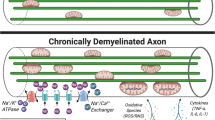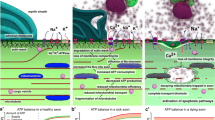Abstract
Multiple sclerosis (MS) is a chronic disease of the central nervous system, affecting more than 2 million people worldwide. Traditionally considered an inflammatory demyelinating disease, recent evidence now points to axonal degeneration as crucial to the development of irreversible disability. Studies show that axonal degeneration occurs throughout the entire course of MS. Although the specific mechanisms causing axonal damage may differ at various stages, mitochondrial failure seems to be a common underlying theme. This review addresses the mitochondrial hypothesis for axonal degeneration in MS, highlighting the mechanisms by which mitochondrial dysfunction leads to axonal disruption in acute inflammatory lesions and the chronic axonopathy in progressive MS. Emphasis is placed on Ca2+, free radical production, and permeability transition pore opening as key players in mitochondrial failure, axonal transport impairment, and subsequent axonal degeneration. In addition, the role of mitochondria as therapeutic targets for neuroprotection in MS is addressed.
Similar content being viewed by others
References and Recommended Reading
Noseworthy J, Lucchinetti C, Rodriguez M, et al.: Multiple sclerosis. N Engl J Med 2000, 343:938–952.
Schmidt S: Candidate autoantigens in multiple sclerosis. Mult Scler 1999, 5:147–160.
Huitinga I, van Rooijen N, de Groot CJ, et al.: Suppression of experimental allergic encephalomyelitis in Lewis rats after elimination of macrophages. J Exp Med 1990, 172:1025–1033.
De Jager PL, Hafler DA: New therapeutic approaches for multiple sclerosis. Annu Rev Med 2007, 58:417–432.
Kuhlmann T, Lingfeld G, Bitsch A, et al.: Acute axonal damage in multiple sclerosis is most extensive in early disease stages and decreases over time. Brain 2002, 125:2202–2212.
Herrero-Herranz E, Pardo LA, Gold R, Linker RA: Pattern of axonal injury in murine myelin oligodendrocyte glycoprotein induced experimental autoimmune encephalomyelitis: implications for multiple sclerosis. Neurobiol Dis 2008, 30:162–173.
Kutzelnigg A, Lucchinetti CF, Stadelmann C, et al.: Cortical demyelination and diffuse white matter injury in multiple sclerosis. Brain 2005, 128:2705–2712.
Ingle GT, Stevenson VL, Miller DH, et al.: Primary progressive multiple sclerosis: a 5-year clinical and MR study. Brain 2003, 126:2528–2536.
Trapp BD, Peterson J, Ransohoff RM, et al.: Axonal transection in the lesions of multiple sclerosis. N Engl J Med 1998, 338:278–285.
Lovas G, Szilágyi N, Majtényi K, et al.: Axonal changes in chronic demyelinated cervical spinal cord plaques. Brain 2000, 123:308–317.
Lu ZH, Chakraborty G, Ledeen RW, et al.: N-Acetylaspartate synthase is bimodally expressed in microsomes and mitochondria of brain. Brain Res Mol Brain Res 2004, 122:71–78.
Signoretti S, Marmarou A, Tavazzi B, et al.: N-Acetylaspartate reduction as a measure of injury severity and mitochondrial dysfunction following traumatic brain injury. J Neurotrauma 2001, 18:977–991.
Benarroch EE: N-Acetylaspartate and N-acetylaspartylglutamate: neurobiology and clinical significance. Neurology 2008, 70:1353–1357.
Fu L, Matthews PM, De Stefano N, et al.: Imaging axonal damage of normal appearing white matter in multiple sclerosis. Brain 1998, 121:103–113.
Khan O, Shen Y, Caon C, et al.: Axonal metabolic recovery and potential neuroprotective effect of glatiramer acetate in relapsing-remitting multiple sclerosis. Mult Scler 2005, 11:646–651.
Bjartmar C, Kidd G, Mork S, et al.: Neurological disability correlates with spinal cord axonal loss and reduced Nacetyl aspartate in chronic multiple sclerosis patients. Ann Neurol 2000, 48:893–901.
Lu F, Selak M, O’Conner J, et al.: Oxidative damage to mitochondrial DNA and activity of mitochondrial enzymes in chronic active lesions of multiple sclerosis. J Neurol Sci 2000, 177:95–103.
Dutta R, McDonough J, Yin X, et al.: Mitochondrial dysfunction as a cause of axonal degeneration in multiple sclerosis patients. Ann Neurol 2006, 59:478–489.
Bernardi P, Krauskopf A, Basso E, et al.: The mitochondrial permeability transition from in vitro artifact to disease target. FEBS J 2006, 273:2077–2099.
Bogdan C: Nitric oxide and the immune response. Nat Immunol 2001, 2:907–916.
Brown GC, Borutaite V: Nitric oxide, mitochondria, and cell death. IUBMB Life 2001, 52:189–195.
Cleeter MW, Cooper JM, Darley-Usmar VM, et al.: Reversible inhibition of cytochrome c oxidase, the terminal enzyme of the mitochondrial respiratory chain, by nitric oxide. Implications for neurodegenerative diseases. FEBS Lett 1994, 345:50–54.
Brown GC, Borutaite V: Nitric oxide inhibition of mitochondrial respiration and its role in cell death. Free Radic Biol Med 2002, 33:1440–1450.
Beckman JS, Koppenol WH: Nitric oxide, superoxide, and peroxynitrite: the good, the bad, and ugly. Am J Physiol 1996, 271:C1424–C1437.
Pacher P, Beckman JS, Liaudet L: Nitric oxide and peroxynitrite in health and disease. Physiol Rev 2007, 87:315–424.
Cross A, Manning PT, Keeling RM, et al.: Peroxynitrite formation within the central nervous system in active multiple sclerosis. J Neuroimmunol 1998, 88:45–56.
Groom AJ, Smith T, Turski L: Multiple sclerosis and glutamate. Ann N Y Acad Sci 2003, 993:229–275.
Gunter TE, Yule DL, Gunter KK, et al.: Calcium and mitochondria. FEBS Lett 2004, 567:96–102.
Srinivasan R, Sailasuta N, Hurd R, et al.: Evidence of elevated glutamate in multiple sclerosis using magnetic resonance spectroscopy at 3 T. Brain 2005, 128:1016–1025.
Craner M, Newcombe J, Black JA, et al.: Molecular changes in neurons in multiple sclerosis: altered axonal expression of Nav1.2 and Nav1.6 sodium channels and Na+/Ca2+ exchanger. Proc Natl Acad Sci U S A 2004, 101:8168–8173.
Stys PK, Waxman SG, Ransom BR: Ionic mechanisms of anoxic injury in mammalian CNS white matter: role of Na+ channels and Na+-Ca2+ exchanger. J Neurosci 1992, 12:430–439.
Krieger C, Duchen MR: Mitochondria, Ca2+ and neurodegenerative disease. Eur J Pharmacol 2002, 447:177–188.
Gunter TE, Sheu SS: Characteristics and possible functions of mitochondrial Ca(2+) transport mechanisms. Biochim Biophys Acta 2009 Jan 6 (Epub ahead of print).
Griffiths EJ, Halestrap AP: Protection by cyclosporin A of ischemia/reperfusion-induced damage in isolated rat hearts. J Mol Cell Cardiol 1993, 25:1461–1469.
Friberg H, Ferrand-Drake M, Bengtsson F, et al.: Cyclosporin A, but not FK 506, protects mitochondria and neurons against hypoglycemic damage and implicates the mitochondrial permeability transition in cell death. J Neurosci 1998, 18:5151–5159.
Basso E, Fante L, Folkes J, et al.: Properties of the permeability transition pore in mitochondria devoid of cyclophilin D. J Biol Chem 2005, 280:18558–18561.
Baines CP, Kaiser RA, Purcell NH, et al.: Loss of cyclophilin D reveals a critical role for mitochondrial permeability transition in cell death. Nature 2005, 434:658–662.
Schinzel AC, Takeuchi O, Huang Z, et al.: Cyclophilin D is a component of mitochondrial permeability transition and mediates neuronal cell death after focal cerebral ischemia. Proc Natl Acad Sci U S A 2007, 102:12005–12010.
Forte M, Gold BG, Marracci G, et al.: Cyclophilin D inactivation protects axons in experimental autoimmune encephalomyelitis, an animal model of multiple sclerosis. Proc Natl Acad Sci U S A 2007, 104:7558–7563.
Chen H, Chan DC: Critical dependence of neurons on mitochondrial dynamics. Curr Opin Cell Biol 2006, 18:453–459.
Hollenbeck PJ, Saxton WM: The axonal transport of mitochondria. J Cell Sci 2005, 118:5411–5419.
Saotome M, Safiulina D, Szabadkai G, et al.: Bidirectional Ca2+-dependent control of mitochondrial dynamics by the Miro GTPase. Proc Natl Acad Sci U S A 2008, 52:20728–20733.
Wang X, Schwarz TL: The mechanism of Ca2+-dependent regulation of kinesin-mediated mitochondrial motility. Cell 2009, 136:163–174.
Macaskill AF, Rinholm JE, Twelvetrees AE, et al.: Miro1 is a calcium sensor for glutamate receptor-dependent localization of mitochondria at synapses. Neuron 2009, 61:541–555.
Rintoul GL, Bennett VJ, Papaconstandinou NA, et al.: Nitric oxide inhibits mitochondrial movement in forebrain neurons associated with disruption of mitochondrial membrane potential. J Neurochem 2006, 97:800–806.
Stagi M, Gorlovoy P, Larionov S, et al.: Unloading kinesin transported cargoes from the tubulin track via the inflammatory c-Jun N-terminal kinase pathway. FASEB J 2006, 20:2573–2575.
Morfini GA, You YM, Pollema SL, et al.: Pathogenic huntingtin inhibits fast axonal transport by activating JNK3 and phosphorylating kinesin. Nat Neurosci 2009, 12:864–871.
Nikolaev A, McLaughlin T, O’Leary DD, et al.: APP binds DR6 to trigger axon pruning and neuron death via distinct caspases. Nature 2009, 457:981–989.
Witt A, Brady ST: Unwrapping new layers of complexity in axon/glial relationships. Glia 2000, 29:112–117.
Misgeld T, Kerschensteiner M, Bareyre FM, et al.: Imaging axonal transport of mitochondria in vivo. Nat Methods 2007, 4:559–561.
Author information
Authors and Affiliations
Corresponding author
Rights and permissions
About this article
Cite this article
Su, K.G., Banker, G., Bourdette, D. et al. Axonal degeneration in multiple sclerosis: The mitochondrial hypothesis. Curr Neurol Neurosci Rep 9, 411–417 (2009). https://doi.org/10.1007/s11910-009-0060-3
Published:
Issue Date:
DOI: https://doi.org/10.1007/s11910-009-0060-3




